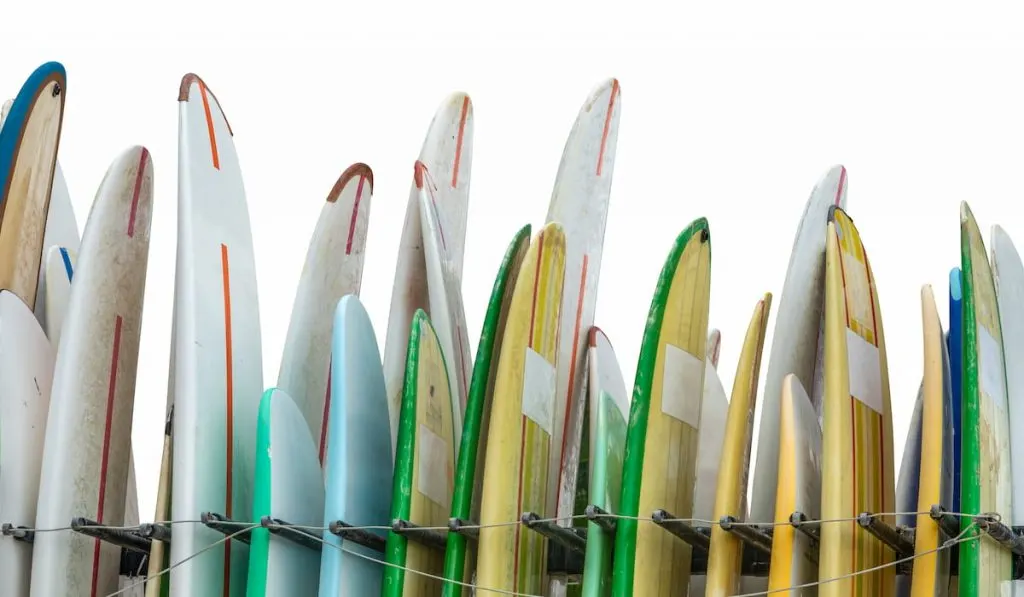Since you will be carrying your surfboard to and from the beach, water, and car yourself, it’s best to get something comfortable for you.
Part of this is being sure that you can lift and carry a longboard surfboard if that is the type you are looking to buy.
How much does a longboard surfboard weigh?
Generally, longboard surfboards are heavier than shortboard surfboards. A longboard surfboard typically weighs around 20 pounds while their shorter opposite weighs an average of 6-7 pounds.

The weight of a surfboard depends on various factors including shape, construction material, and accessories.
Besides that, you may find that the weight of your surfboard changes with time.
How Much Does a Longboard Surfboard Weigh?
Surfboards come in different shapes, and this variation influences their weight.
Some of the most common surfboard shapes include longboard, shortboard, fish, and funboard.
Of these 4 surfboard shapes, longboard surfboards are the longest and have the highest average weight.
On average, longboard surfboards weigh around 20 pounds.
The funboard surfboards, which come close to the longboards, should have an average weight of around 15-16 pounds.
At the smaller end, the shortboard and fish, which are about the same length, should weigh around 6-7 pounds on average.

What Affects the Weight of a Surfboard?
What factors influence the weight of a surfboard? What makes a surfboard heavy or light?
Surfboards can be heavy or light depending on their size, accessories, and construction material.
Size
The size of your surfboard will affect its weight. The length, width, and thickness of a surfboard usually play a vital role in how much the board weighs.
Generally, longer, thicker, and broader surfboards should be relatively heavier. With higher dimensions, a surfboard will have a larger core. This might make them heavier.
Even if a surfboard does not get heavier because of its dimensions, it could become harder to move around.
For example, if you have a surfboard wider than your arm span, you may not be able to wrap your arms around it to carry it.

Accessories
Surfboards may come with various accessories from traction pads to fins, stickers, cameras, and camera mounts.
Adding items on your board can make it even heavier. Alone, the weights of these accessories might be inconsequential.
But when you attach a few of them to your board, you may notice the extra weight both when carrying it and when out on the water.
Construction Material
It goes without saying that the materials used in constructing a surfboard will affect its weight. Remarkably, various types of materials are used in making surfboards.
In surfboards with hard surfaces, the outer core is typically made of resin and a shell of cloth. The inner core of hard surfboards is usually made of foam.
The types of foams most used in constructing the inner core of hard surfboards are PU and Epoxy.
Compared to each other, epoxy (also called polystyrene) is lighter than PU (polyurethane).
In surfboards with soft surfaces, the inner and outer cores are made from foam. So, compared to hard surfboards, you can expect soft surfboards to be lighter.

Why the Weight of Your Surfboard Matters
Does the weight of your surfboard only matter if you plan on carrying it sometimes? Or are there other reasons to consider weight before making a purchase?
One reason why you should pay attention to the weight of your surfboard is speed. Heavier boards are more likely to move at slower speeds compared to the lighter ones.
Apart from speed, weight matters in the floatation of your surfboard. Compared to the lighter boards, heavy boards will have lower floatation.
A relatively larger portion of a heavy surfboard will sit in the water, and this will cause it to have more drag.
With increased drag, paddling is slower, but maneuvering your way through waves might be easy.
You can expect the opposite from a lighter surfboard. The lightness comes with more buoyancy, which means the board floats better and sits higher atop the water.
This, in turn, means less drag, faster paddling, and increased ease of catching waves. But it also means slower maneuverability.

Why Surfboards Get Heavier With Time
You may notice that over time, your surfboard feels heavier than it was when you bought it. There are actually a few reasons to justify the possibility of this phenomenon.
Waterlog
Normally, surfboards are expected to be watertight to keep water out of the inner core. But over time, these boards do not retain the integrity they were originally made with. As surfboards get older, they get damaged and develop cracks and dings.
With these cracks or dings in place, protection against water is reduced. Water gets into the board and into the inner core.
The foam in the inner core soaks the water, retains it, and becomes heavier. As expected, the surfboard becomes heavier too. This occurrence is worsened by the fact that the water may not be removed entirely.
Waxing
Wax is applied on the surface of a surfboard to provide extra traction. But then, wax can also add weight to your surfboard with time.
Many surfers wax their surfboards regularly, but instead of removing old wax before applying a new one, they pile on the layers. Over time, the wax layers accumulate and add some weight to the boards.
Repairs
As surfboards get older, they will not be as strong as they were. This makes them more prone to damage.
When you repair damage, the board can take on some extra weight, especially if the issue was large or significant.
For example, when repairing hard-shell cracks on a board, you refill the cracks with material that can add weight to the board over time.
Conclusion
Longboard surfboards have an average weight of 20 pounds.
Their weights vary depending on factors such as size, construction materials, and accessories.
The age of a surfboard and how long it has been in use can also affect its weight.
Resources
- https://surfmentor.com/what-is-the-average-weight-of-a-surfboard/
- https://surfersfootprint.com/average-surfboard-weight-with-25-examples/
- https://greenlightsurfsupply.com/blogs/news/what-is-the-difference-between-eps-expanded-polystyrene-and-polyurethane-pu-foam-surfboard-blanks
- https://www.liveabout.com/polyurethane-or-polystyrene-foam-3154881
